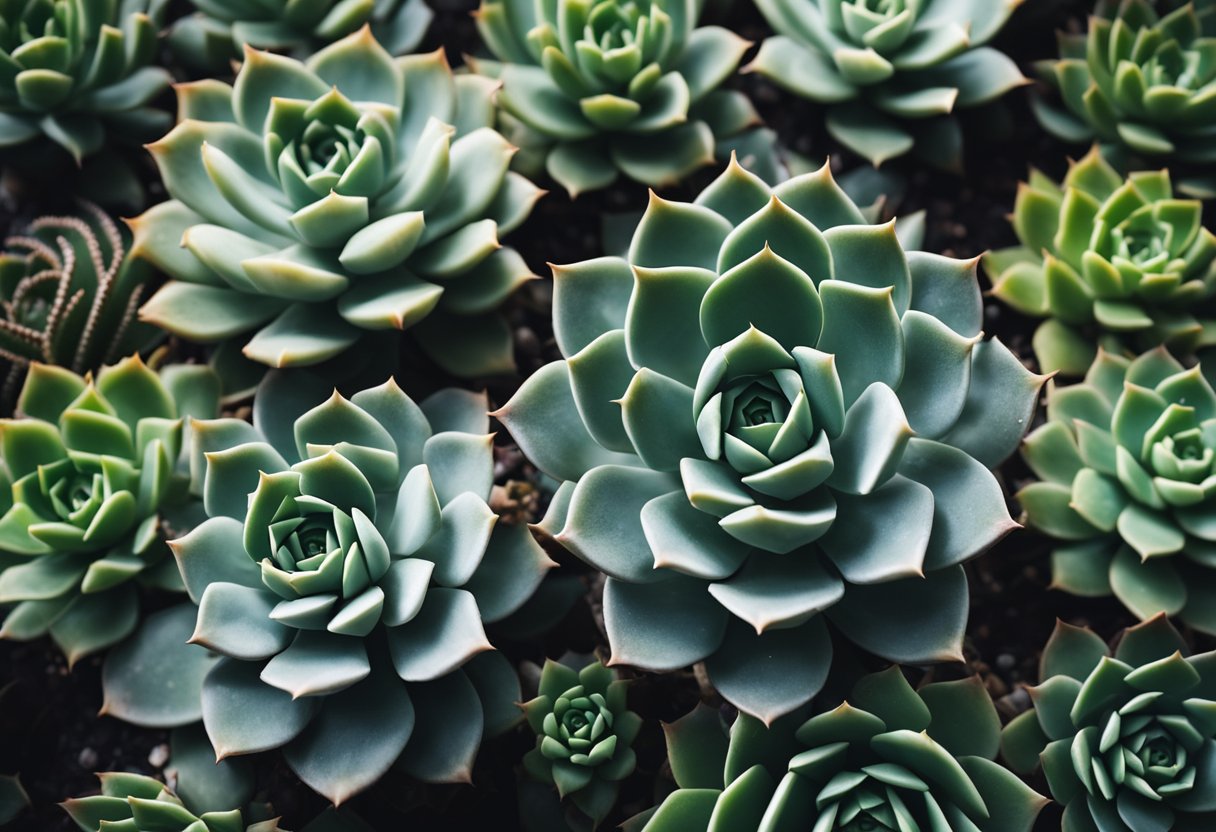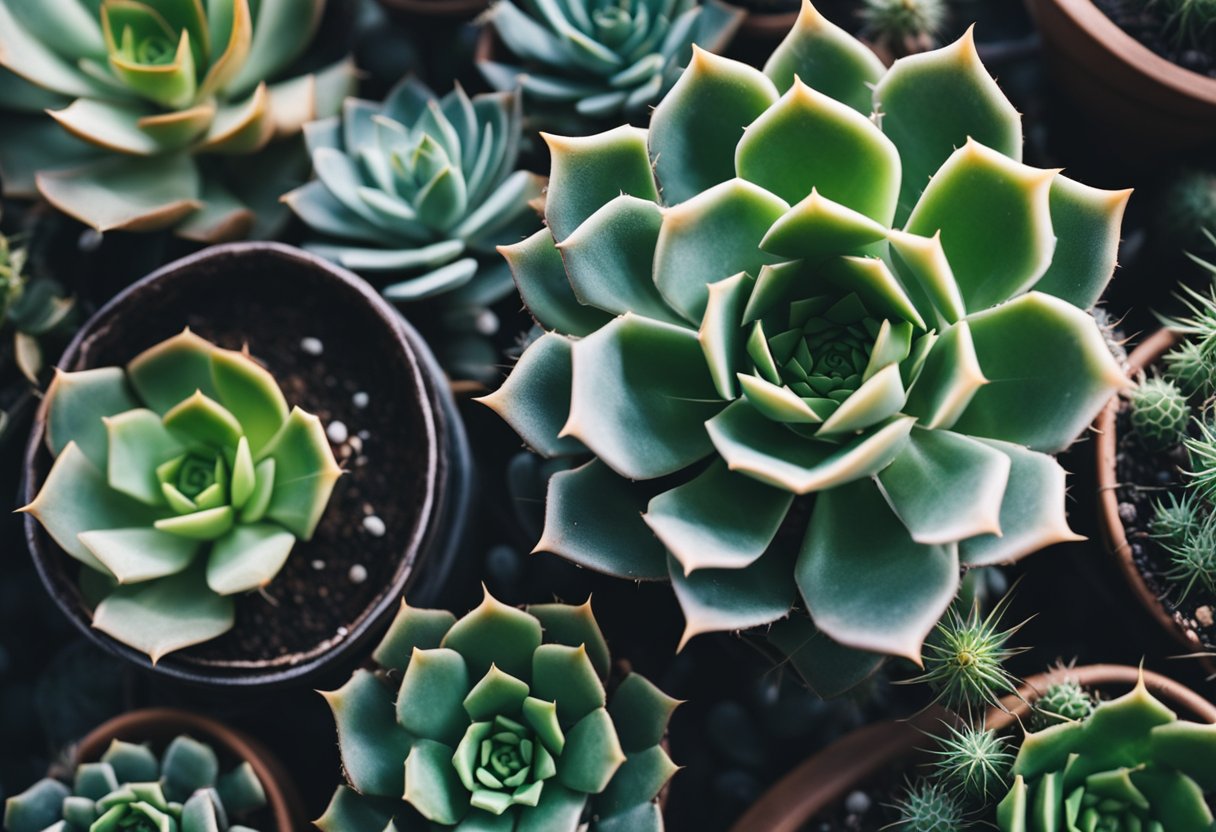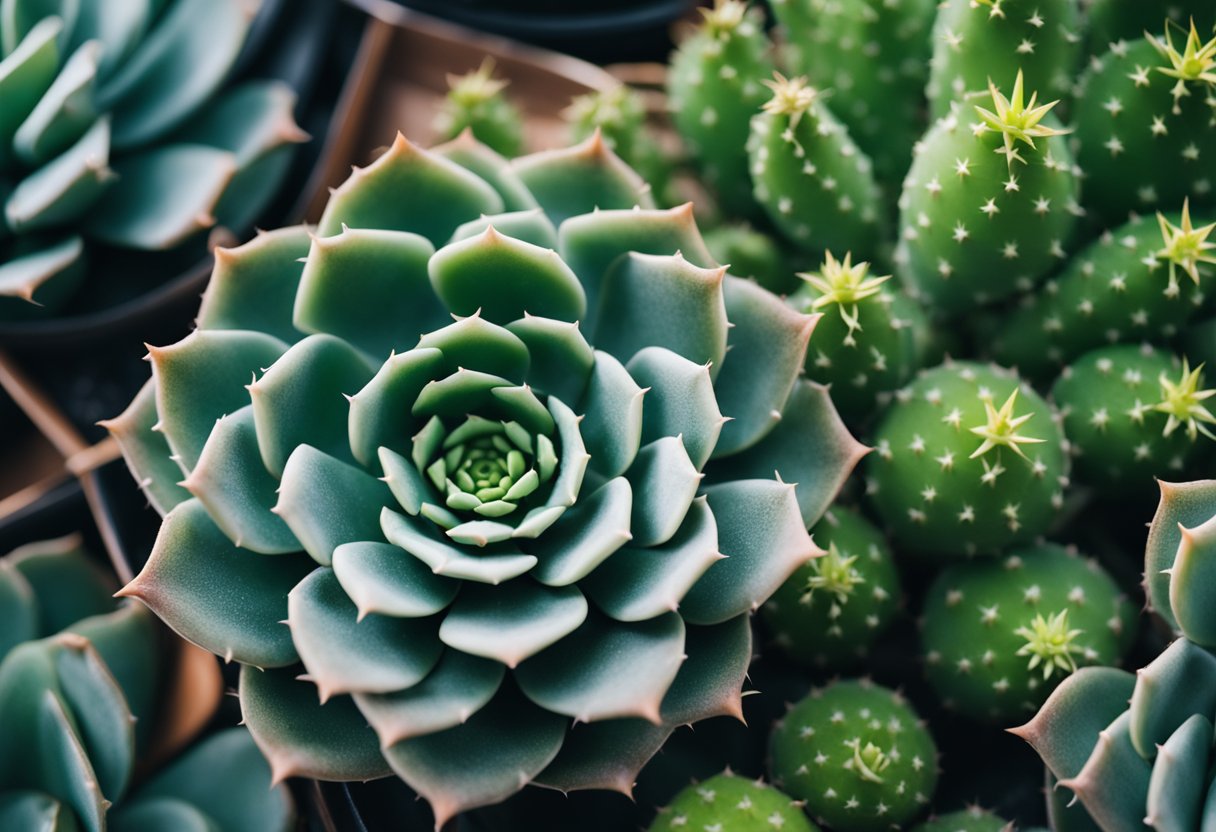Difference Between Succulents and Cacti: A Clear and Knowledgeable Guide
Succulents and cacti are two of the most popular plant types in the world. Both are known for their striking appearance and low maintenance needs, making them perfect for those who want to add a touch of greenery to their homes but don’t have a lot of time to care for plants. However, despite their similarities, there are some key differences between succulents and cacti that are worth noting.
This post may contain affiliate links, which means I’ll receive a commission if you purchase through my link, at no extra cost to you. Please read full disclosure here.

One of the most significant differences between succulents and cacti is their appearance. While both plants store water in their leaves, stems, and roots, cacti are more easily identified by their spines. These spines are actually modified leaves that evolved to protect the plant from predators and help it retain moisture. Succulents, on the other hand, may have small, inconspicuous leaves or no leaves at all.
Another difference between succulents and cacti is their native habitats. While both plants are adapted to arid environments, cacti are typically found in the Americas, from the deserts of the southwestern United States to the rainforests of South America. Succulents, on the other hand, can be found in a wide variety of locations around the world, from the deserts of Africa to the mountains of Europe and Asia. Understanding these differences can help gardeners choose the right plant for their needs and ensure that they are providing the right growing conditions for their chosen species.
Understanding Succulents and Cacti

Succulents and cacti are two types of plants that share many similarities, but also have some key differences. Both are adapted to harsh, arid environments and are known for their ability to store water in their leaves, stems, and roots. However, cacti are a specific type of succulent that are characterized by their spines or thorns.
Physical Appearance
One of the most obvious differences between succulents and cacti is their physical appearance. While both types of plants have fleshy leaves or stems that store water, cacti are typically more rigid and have a more defined shape. This is due to their unique structure, which includes a central stem or trunk that is covered in spines or thorns. Succulents, on the other hand, come in a wide variety of shapes and sizes, and can have leaves that are smooth, waxy, or even fuzzy.
Origin and Distribution
Succulents and cacti are both found in arid regions around the world, but they have different origins and distributions. Cacti are native to the Americas, from Canada to Argentina, while succulents can be found in many parts of the world, including Africa, Madagascar, and Australia.
Leaf Structure
Another key difference between succulents and cacti is their leaf structure. While both types of plants store water in their leaves, cacti have evolved to minimize water loss by reducing the surface area of their leaves. Instead, cacti have spines or thorns that protect them from predators and help to shade the plant from the sun. Succulents, on the other hand, have a wider variety of leaf structures, and can have leaves that are flat, round, or even triangular.
Flowering Patterns
Both succulents and cacti are known for their beautiful flowers, but they have different flowering patterns. Cacti typically have large, showy flowers that bloom for a short period of time, often at night. Succulents, on the other hand, can have flowers that bloom for longer periods of time, and may be smaller and less showy than cactus flowers.
In conclusion, while succulents and cacti share many similarities, they also have some key differences that set them apart. Understanding these differences can help gardeners choose the right type of plant for their needs, and appreciate the unique beauty of each species.
Physical Characteristics

Succulents and cacti share some physical characteristics, but there are also some notable differences. Both types of plants have adapted to arid environments and have developed ways to store water in their leaves, stems, and roots.
One of the most distinctive features of cacti is their spines or thorns. These structures are modified leaves that have evolved to protect the plant from predators and to reduce water loss through transpiration. In contrast, most succulents have thin, fleshy leaves or stems that store water and do not have spines.
Cacti also have round, grooved stems that are divided into segments called ribs. These ribs allow the plant to expand and contract as it absorbs and releases water. In addition, cacti have areoles, which are small, raised structures that produce spines, flowers, and new branches.
Succulents, on the other hand, have a wide variety of stem and leaf shapes. Some succulents have thick, fleshy leaves that are adapted for water storage, while others have thin, elongated leaves that help the plant to conserve water. Some succulents also have branches that grow close to the ground, while others can grow tall and tree-like.
While cacti and succulents share many physical characteristics, there are some key differences that can help you tell them apart. If you see a plant with spines and spherical growth, it is likely a cactus. If you see a plant with thickened leaves and no spines, it is likely a succulent.
Water Storage Mechanisms
Both succulents and cacti have adapted to survive in arid environments by developing specialized water storage mechanisms. These mechanisms allow them to store water in their stems, leaves, and roots, which they can use during periods of drought.
Cacti are perhaps the most well-known for their water storage capabilities. They have thick, fleshy stems that can store large amounts of water. In addition, cacti have shallow root systems that allow them to quickly absorb water from the soil when it becomes available. This allows cacti to survive in extremely dry environments where other plants would not be able to.
Succulents, on the other hand, also have fleshy stems and leaves that can store water. However, they typically have deeper root systems than cacti, which allows them to access water from deeper in the soil. Some succulent plants also prefer to be planted in clay pots to help regulate water absorption, as they are more susceptible to root rot from overwatering than cacti.
While both cacti and succulent plants have succulent stems for water storage, cacti generally store more water and are more tolerant of excess water than other succulent plant types. In fact, overwatering can be a problem for succulents, as it can lead to root rot and other issues.
In summary, both succulents and cacti have developed specialized water storage mechanisms that allow them to survive in arid environments. While cacti have shallow root systems and can store more water than other succulent plant types, succulents typically have deeper root systems and are more susceptible to root rot from overwatering.
Popular Varieties
Cacti Varieties
Cacti come in many different shapes and sizes. One of the most well-known cacti is the Saguaro (Carnegiea gigantea), which is found in the Sonora Desert and can grow up to 60 feet tall. Another popular cactus is the Prickly Pear (Opuntia), which has flat, paddle-shaped segments and produces edible fruit. The Giant Saguaro (Carnegiea gigantea) is another impressive cactus that can live for over 150 years and store up to 200 gallons of water in its trunk.
Succulent Varieties
Succulents also come in a wide variety of shapes and sizes. One of the most popular succulent varieties is Aloe (Aloe vera), which is known for its medicinal properties and can be used to soothe burns and other skin irritations. Another common succulent is Agave, which is often used to make tequila and has large, thick leaves that store water. Sedum is another popular succulent that comes in many different varieties and is often used in rock gardens or as ground cover. Other popular succulent varieties include Sempervivum, Purslane, Hens and Chicks, and Euphorbia horrida.
Non-Cactus Succulents
While cacti are a type of succulent, not all succulents are cacti. Non-cactus succulents include stem succulents like Euphorbias, as well as other varieties of Agaves, Aloes, and Haworthia. These plants are also known for their ability to store water in their leaves and stems, making them well-suited for arid environments.
In conclusion, both cacti and succulents come in many different varieties and can be found in a wide range of environments. Whether you prefer the spiny, desert-dwelling cacti or the fleshy, colorful succulents, there is sure to be a variety that will thrive in your garden or home.
Habitat and Adaptations
Succulents and cacti have evolved to thrive in harsh environments, such as deserts, where water is scarce and temperatures can be extreme. They have developed a number of adaptations to survive in these conditions.
Habitat
Both succulents and cacti are found in arid regions, such as deserts, where rainfall is limited. Cacti are typically found in the Americas, from Canada to Argentina, while succulents are found in many parts of the world, including Africa, Madagascar, and the Americas. Some succulents, such as the jade plant, are also found in rainforests.
Adaptations
One of the most important adaptations of succulents and cacti is their ability to store water in their leaves, stems, and roots. This allows them to survive long periods of drought. They also have shallow roots that can quickly absorb water when it is available.
Cacti have adapted to their environment by developing spines, which protect them from predators and help to reduce water loss. Some cacti also have thick, waxy coatings on their stems, which help to prevent water loss through evaporation.
Succulents have developed adaptations to help them survive in different environments. For example, some succulents have developed a form of photosynthesis called crassulacean acid metabolism (CAM), which allows them to take in carbon dioxide at night and store it until the next day, when they can use it for photosynthesis. This adaptation helps them to conserve water during the day, when the sun is hottest.
Sunlight and Bright Light
Succulents and cacti are adapted to bright light and direct sunlight. They have developed thick, waxy coatings on their leaves and stems, which help to protect them from damage caused by the sun’s rays.
Rainfall and USDA Plant Hardiness Zone
Succulents and cacti are adapted to low rainfall and are able to survive in USDA plant hardiness zones 9 through 11. They are also able to survive in areas with high temperatures and low humidity.
Predators
Succulents and cacti have developed a number of adaptations to protect themselves from predators. Cacti have spines, which protect them from herbivores, and some succulents have developed thorns or prickles for the same purpose.
In conclusion, succulents and cacti have evolved to survive in harsh environments, such as deserts, by developing a number of adaptations. They are able to store water, survive on low rainfall, and protect themselves from predators. These adaptations make them well-suited to their environment and allow them to thrive in conditions that would be inhospitable to other plants.
Reproduction and Growth
Succulents and cacti are both flowering plants, reproducing through seeds. Succulents generally produce more flowers than cacti, but cacti flowers are usually larger and more colorful. Both plants can produce fruit, with the fruit of cacti being edible in some species.
When it comes to potting, both succulents and cacti need well-draining soil to prevent root rot. However, cacti prefer a more alkaline soil, while succulents can tolerate a wider range of pH levels. It is important to choose a pot with drainage holes to allow excess water to escape.
Succulents and cacti have different blooming and flowering patterns. Cacti usually bloom in the spring or summer, while succulents can bloom at any time of the year. The blooming period for both plants can last for several weeks.
Succulents and cacti can change their appearance during different seasons or growth stages. Some cacti can produce mucilage, a sticky substance that helps them retain moisture during dry periods. Some succulents have grooves or wrinkles on their leaves or stems, which can expand or contract depending on the amount of water they store.
Overall, succulents and cacti are both low-maintenance plants that can thrive in a variety of environments. With proper care and attention, they can provide years of enjoyment to their owners.
Care and Maintenance
Succulents and cacti are known for their low maintenance and ease of care. However, they still require some attention to thrive and look their best.
Watering
One of the most important aspects of succulent and cacti care is watering. These plants are adapted to survive in arid environments and store water in their leaves, stems, or roots. Overwatering can lead to root rot, so it’s crucial to let the soil dry out completely between waterings. A good rule of thumb is to water when the top inch of soil is dry to the touch.
Sunlight
Succulents and cacti both need plenty of direct sunlight to grow and thrive. They should be placed in a sunny window or outside in a spot with at least six hours of direct sunlight per day. However, too much direct sunlight can cause sunburn and damage to the plant. If the leaves or stems start to turn brown or black, it’s a sign that the plant is getting too much sun.
Soil
Succulents and cacti need well-draining soil to prevent root rot. A mix of potting soil, sand, and perlite or pumice is ideal. It’s important to avoid using regular potting soil, which can hold too much moisture and suffocate the roots.
Pest Control
Succulents and cacti are relatively pest-free, but they can still attract mealybugs, spider mites, and other common houseplant pests. Regularly inspect the plants for signs of infestation, such as webbing or sticky residue on the leaves. If pests are present, remove them with a cotton swab dipped in rubbing alcohol.
Future
As houseplants, succulents and cacti are becoming increasingly popular due to their unique shapes, colors, and ease of care. With proper care and maintenance, they can thrive for years and even decades.
Popularity
Succulents and cacti have gained popularity in recent years due to their low maintenance and unique appearance. They are perfect for busy people who want to enjoy the beauty of plants without spending too much time caring for them.
Scientific Classification
Succulents and cacti are both classified as members of the Plantae kingdom and the Angiosperms division. However, they differ in their scientific classifications. Cacti belong to the family Cactaceae, which is a unique family of plants that are native to the Americas. On the other hand, succulents are a broader group of plants that belong to several botanical families, including the Euphorbia genus, Didiereaceae family, and more.
Cacti are further classified into several genera, including Opuntia, Mammillaria, and Ferocactus, among others. These genera are further divided into species based on their unique characteristics. For example, the Opuntia genus includes species like the prickly pear cactus, while the Mammillaria genus includes species like the pincushion cactus.
Succulents, on the other hand, are classified based on their unique characteristics, such as the ability to store water in their leaves, stems, or roots. Some popular succulent families include the Aizoaceae family, which includes species like the Lithops, and the Crassulaceae family, which includes species like the jade plant.
Botanists and horticulturists use these classifications to identify and study different species of cacti and succulents. Understanding the scientific classifications of these plants is essential for their proper care and maintenance.